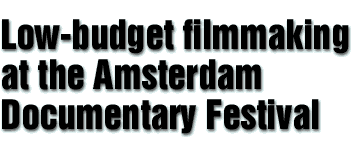|
 |
||
| Report by John Digance |
Imagine an almost full 600 seat city centre cinema on a weekend afternoon and a feature length documentary being shown. The explanation could only be a festival and on the last week of November each year it's the International Documentary Filmfestival in Amsterdam where 150 film and video documentaries are shown at 7 screens for 8 days, from 10am till gone midnight.
The festival circuit isn't only for established directors like Nick Broomfield who had a retrospective at the last Amsterdam festival. It is also an opportunity for new and low budget filmmakers to have their work exhibited, meet filmmakers from around the world and maybe interest a buyer. And don't forget, the British Council may pay your expenses if your film or video is accepted for a foreign festival.
Amsterdam successfully combines elements of market and festival. Its Forum is an opportunity for producers to pitch projects to European commissioning editors. A video library enables buyers to view recent documentaries.
In contrast each year a director selects 10 films from the history of documentary. In 1998, it was Kazuo Hara, the Japanese director of The Emperors Naked Army Marches On.
The festival has several programme categories. Selections in the £8,000 Joris Ivens and £3,000 Silver Wolf awards for respectively the best film and video in competition tend to be well budgeted and by established directors. Megacities, a glossy 35mm film from Austria about life on the edge in four photogenic poverty stricken cities had, ironically, a lavish £600,000 of cross European funding.
Low/no budget documentaries are represented in the First Appearance section where one first time director wins the £1,500 Fipresci award. Visions shows work from European film schools whilst the Platform section exhibits films from developing countries with financial support for exhibition copies. In the latter Sunanda Bhat showed a 45 minute video, Bol Ayeshabol Bol (Speak Ayesha Speak) which, within a conventional style of voice over and interviews, shows women in a Union of poor agricultural labourers in Southern India organising against the pressures of landlords, money lenders, a male dominated culture and unproductive farmland. Despite its harsh subject matter the film affirms the possibility of change and has uplifting moments like a shadow puppet performance and laughing men and women spontaneously breaking convention by swimming, fully clothed, together in the village pond.
Bhat's £8,000 two film budget came from the Save the Children Fund. European filmmakers finance films about South Asia far more easily than indigenous documentarists making films about their own societies for whom independent home finance is almost impossible.
Bhat related her low budget improvisation to the film's aim...
Full article published in Filmwaves - Issue 7, Spring 1999. Subscribe now!
